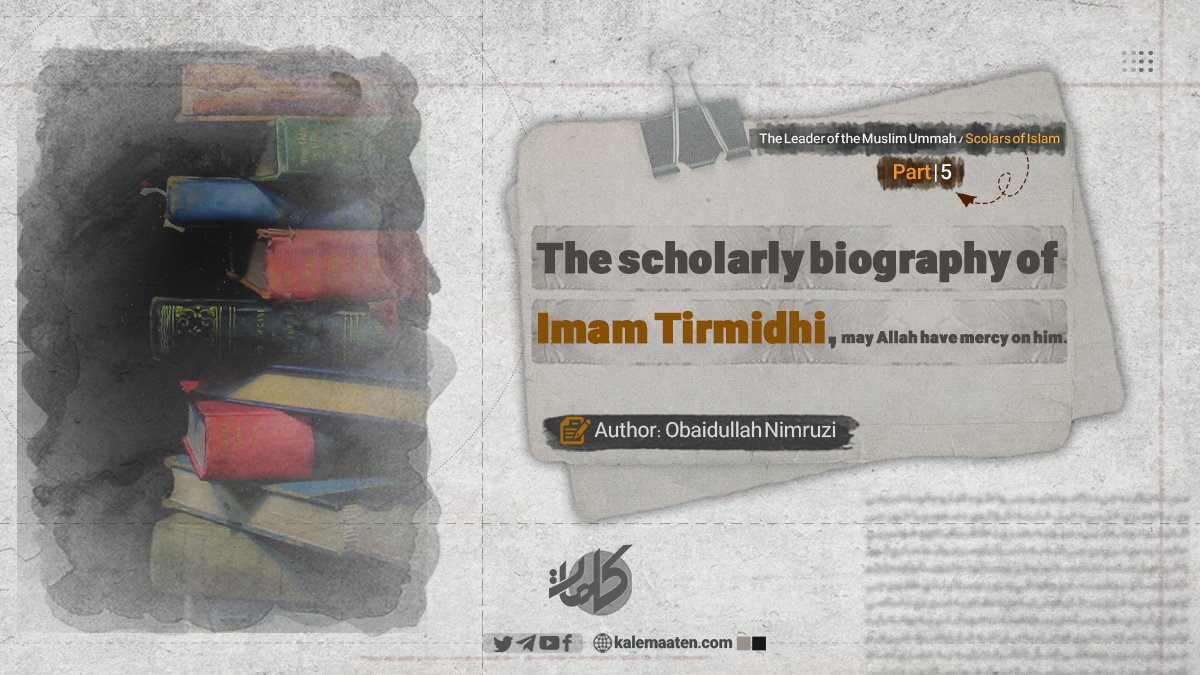
Author: Obaidullah Nimruzi
The Scholarly Biography of Imam Tirmidhi ‘May Allah Have Mercy on Him’ (Part 5)
Imam Tirmidhi’s Attention to the Differences in the Words of Narrations
If there is a difference between the words of the narrators, Imam Tirmidhi pays attention to it and refers to this difference in three ways:
1. Mentioning the phrase «المعنی واحد» (“the meaning is the same”): In cases where the difference in the words of the narrations is minor and the general concept remains the same, Imam Tirmidhi uses the phrase “the meaning is the same.” Example: On the subject of camel zakat, he says: «حدثنا زیاد بن أیوب البغدادی وإبراهیم بن عبدالله الهروی ومحمد بن کامل المروزی -المعنی واحد- قالوا: حدثنا عباد بن العوام عن سفیان بن حسین عن الزهری عن سالم عن أبیه أن رسول الله صلیاللهعلیهوسلم کتب کتاب الصدقة…» Translation: “Ziyad ibn Ayyub al-Baghdadi, Ibrahim ibn Abdullah al-Harwi, and Muhammad ibn Kamil al-Marozi—the meaning is the same—told us: ‘Abbad ibn al-Awwam narrated from Sufyan ibn Husayn from al-Zuhri from Salim from Abu Yahya that the Messenger of Allah, may Allah’s prayers and peace be upon him, wrote the Book of Charity…”
2. Identifying the narrator who has a specific word: In some cases, Imam Tirmidhi specifies from which of the narrators the mentioned words were narrated. Example: On the subject of expiation of the fast-during Ramadan, he says: «حدثنا نضر بن علی الجهضمی وأبو عمار -المعنی واحد واللفظ لفظ أبی عمار- قالا: أخبرنا سفیان بن عینیة عن الزهری عن حُمید بن عبدالرحمن عن أبی هریرة…» Translation: “We were told by Nazr ibn Ali al-Jahdhami and Abu Ammar—the meaning is the same—and the wording is the wording of Abu Ammar—they said: Sufyan ibn Ainiyah told us on the authority of al-Zuhri on the authority of Humaid ibn Abd al-Rahman on the authority of Abu Hurairah…”
3. Explaining the difference in the words of each narrator separately: Imam Tirmidhi sometimes directly explains the difference in the words of the narrators. Example: On the subject of what came about in the mercy of the child, he says: «حدثنا ابن أبی عمر وسعید بن عبدالرحمن قالا: حدثنا سفیان عن الزهری عن أبی سلمة عن أبی هریرة قال: أبصر الأقرع بن حابس النبی صلیاللهعلیهوسلم وهو یقبل الحسن، وقال ابن أبی عمر: الحسن أو الحسین» Translation: “Ibn Abi Umar and Saeed ibn Abd al-Rahman told us: Sufyan told us on the authority of al-Zuhri on the authority of Abu Salamah on the authority of Abu Hurairah, who said: Al-Aqra’ ibn Habis saw the Prophet, may Allah bless him and grant him peace, while he was accepting al-Hasan, and Ibn Abi Umar said: al-Hasan or al-Hussain.” In this example, Imam Tirmidhi directly mentioned the difference in the words and pointed to the exact words of each narrator.
In this example, Imam Tirmidhi directly mentioned the difference in the words and pointed to the exact words of each narrator.
Imam Tirmidhi’s Attention to the Phrases of Hadith
In narrating hadiths, Imam Tirmidhi carefully mentions the phrases of hadith such as «حدثنا» and «أخبرنا» in the same way he received them from the narrators. This method shows Imam Tirmidhi’s trustworthiness in narrating hadith. For example: In the book of asceticism, he says: «حدثنا صالح بن عبدالله وسوید بن نصر قال صالح: حدثنا وقال سوید: أخبرنا عبدالله بن المبارک عن عبدالله بن سعید بن أبی هند عن أبیه عن ابن عباس قال: قال رسول الله صلیاللهعلیهوسلم: “نعمتان…” ».
In this narration, Imam Tirmidhi has carefully explained the difference between his two sheikhs, Salih and Suwayd, in the use of the phrases «حدثنا» and «أخبرنا». This accuracy shows Imam Tirmidhi’s belief in the semantic difference between these phrases.
B: Stating a number of chains of transmission of a hadith and mentioning its text only after the first chain of transmission
The second method of Imam Tirmidhi in narrating a hadith and stating its methods is that he narrates a hadith in several ways. In this way, he first mentions a hadith with its chain of transmission and text and then refers to the text of the other chains of transmission without mentioning the text, only with phrases such as ‘the same’ «مثله» or ‘in this manner’ «نحوه».
As he says in the book of manners: «حدثنا محمود بن غیلان حدثنا قبیصة حدثنا سفیان عن حبیب بن الشهید عن ابی مجلز قال: خرج معاویة فقام عبدالله بن الزبیر وابن صفوان حین رآوه فقال: اجلسا… الحدیث.» Then Imam Tirmidhi Said: «قال ابوعیسی: هذا حدیث حسن؛ وحدثنا هناد حدثنا ابواسامة عن حبیب بن الشهید عن ابی مجلز عن معاویة عن النبی صلیاللهعلیهوسلم نحوه.» Translation: “Mahmoud ibn Ghailan narrated to us, Qabisah narrated to us, Sufyan narrated to us from Habib ibn al-Shaheed from Abu Majlaz, who said: Muawiyah came out, so Abdullah ibn al-Zubayr and Ibn Safwan stood up while he was watching him and said: ‘Sit down… the hadith.’” Then Imam Tirmidhi adds: “Abu ‘Isa said: This is Hasan hadith; and he narrated to us from this, narrated to us from Abu Usamah from Habib ibn al-Shaheed from Abu Majlaz from Muawiyah from the Prophet, may Allah bless him and grant him peace, in this manner.”
In the above narration, it can be seen that Imam Tirmidhi used abbreviation and merely referred to the content of the text with the phrase ‘the same’ “نحوه” without reciting it in full.
Similarly, in the chapter “«ما جاء لا تنکح المرأة علی عمتها ولا علی خالتها» he says: «حدثنا نصر بن علی الجهضمی حدثنا عبدالاعلی حدثنا سعید بن عروبة عن ابی حریز عن عکرمة عن ابن عباس ان النبی صلیاللهعلیهوسلم نهی ان تزوج المرأة علی عمتها او علی خالتها.» و پس از آن میگوید: «حدثنا نضر بن علی حدثنا عبدالاعلی عن هشام بن حسان عن ابن سیرین عن ابی هریرة عن النبی صلیاللهعلیهوسلم بمثله.»
In these cases, it is seen that Imam Tirmidhi used abbreviation and in the second chain of transmission, he only referred to it with the phrase “the same” and did not mention the full text of the hadith.
C: Explaining each chain of transmission with its full text
Another method that Imam Tirmidhi used in explaining the methods of transmission is that he narrated a hadith with several chains of transmission, and after each chain of transmission, he mentions the text of the hadith in full. The reason for this method is quite clear, because Imam Tirmidhi wants to point out the differences between the narrations by doing this, for example, differences in words or additions in the text of the hadith. Sometimes he also uses this method to reveal the causes of weakness in the chain of transmission or the text of the hadith.
As he says in the chapter on permission to fast during travel: «حدثنا نصر بن علی الجهضمی حدثنا بشر بن المفضل عن سعید بن یزید عن ابی سلمة عن ابی نضرة عن ابی سعید الخدری قال: کنا نسافر مع رسول الله صلیاللهعلیهوسلم فی رمضان فما یعاب علی الصایم صومه ولا علی المفطر افطاره.» And then Imam Tirmidhi said: «حدثنا نضر بن علی حدثنا یزید بن زریع حدثنا الحریری (ح) وحدثنا سفیان بن وکیع حدثنا عبدالاعلی عن الجریری عن ابی نضرة عن ابی سعید قال: کنا نسافر مع رسول الله صلیاللهعلیهوسلم فمنا الصایم ومنا المفطر فلا یجد المفطر علی الصایم ولا الصایم علی المفطر فکانوا یرون ان من وجد قوة فصام حسن ومن وجد ضعفاً فافطر فحسن.» then he adds: «هذا حدیث حسن صحیح.» Translation: “Nasr ibn Ali al-Jahdhami narrated to us Bishr ibn al-Mudhafld from Saeed ibn Yazid from Abi Salamah from Abi Nadhra from Abi Saeed al-Khudri said: We used to travel with the Messenger of Allah (peace and blessings of Allah be upon him) in Ramadan, so he does not blame the fasting person for his fasting, nor the non-fasting person for breaking his fast.” Then he says: “Nadr ibn Ali narrated to us, Yazid ibn Zari’ narrated to us, Al-Hariri narrated to us, Sufyan ibn Waqi’ narrated to us, Abdul-Ali narrated to us, Al-Jariri narrated to us, Abu Nadrah narrated to us, Abu Sa’id said: We used to travel with the Messenger of Allah (peace and blessings of Allah be upon him), and some of us were fasting and some of us were breaking our fast. The one who breaks his fast does not find the one who breaks his fast, nor does the one who breaks his fast find the one who is fasting. They would see that whoever has the strength to break his fast is good, and whoever has the weakness to break his fast is good.” Then Imam Tirmidhi adds: “This is a Hasan sahih hadith.”
In these hadiths, it is seen that Imam Tirmidhi has mentioned the hadith repeatedly and completely; one to strengthen the hadith and the other to show the additions that are in the second narration, such as the phrase: «فکانوا یرون ان من وجد قوة فصام حسن ومن وجد ضعفاً فافطر حسن.»
D: Citing a chain of transmission with the full text and referring to other chains of transmission:
Sometimes Imam Tirmidhi mentions only one chain of transmission with the full text of the hadith and only refers to other chains of transmission. This method is done in two ways:
1. Mentioning the complete chain of transmission and referring to the suspended chains of transmission: As he says in the chapter on the timing of prayer: «حدثنا اسحاق بن ابراهیم وعبدالاعلی عن سفیان الثوری عن علقمة بن مرثد عن سلیمان بن بریدة عن ابیه قال: اتی النبی صلیاللهعلیهوسلم رجل فسأله عن مواقیت الصلوة… الحدیث. قال ابوعیسی: هذا حدیث حسن غریب صحیح وقد رواه شعبة عن علقمة بن مرثد ایضاً.» Translation: “Ishaq ibn Ibrahim and Abdul-Ala narrated to us from Sufyan al-Thawri from ‘Alqamah ibn Murthid from Sulayman ibn Buraidah from Abu ‘Abiyyah, who said: A man came to the Prophet, may Allah bless him and grant him peace, and he asked him about the timing of prayer… The hadith. Abu ‘Issa said: This is a Hasan hadith, a strange sahih, and Shu’bah narrated it from ‘Alqamah ibn Murthid as well.”
In the above narration, it can be seen that Imam Tirmidhi first mentioned one chain of transmission with its complete text and then referred to Shu’bah’s chain of transmission from ‘Alqamah ibn Murthid, without mentioning the complete chain of transmission of the second chain.
2. Referring to other chains of transmission with the phrase «قد روی من غیر وجه» (“It was narrated from more than one source”): As in the chapter on what came about in the case of one who frees his property upon his death and has no property other than theirs, he says: «حدثنا قتیبة حدثنا حماد بن زید عن ایوب عن ابی قلابة عن ابی المهلب عن عمران بن حصین أن رجلاً من الانصار اعتق ستة اعبد له عند موته… الحدیث. ثم قال: وقد روی من غیر وجه عن عمران بن حصین.» “A short narration was narrated to us by Hammad bin Zaid from Ayyub from Abu Qilabah from Abu Al-Muhallab from Imran bin Husayn that a man from the Ansar freed six of his servants upon his death… Hadith. Then he said: “It was narrated from more than one source from Imran bin Husayn.”
In this narration, Imam Tirmidhi did not mention all the chains of transmission of the hadith of Imran bin Husayn and only pointed out the existence of other chains of transmission.
Continues…


